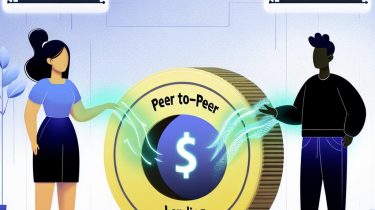What is peer-to-peer lending?

Understanding Peer-to-Peer Lending
Peer-to-peer (P2P) lending is a financial practice which facilitates borrowing and lending of money without involving traditional financial institutions such as banks. By utilizing online platforms, P2P lending allows a direct connection between individual lenders and borrowers, offering a streamlined and accessible financial solution.
How Peer-to-Peer Lending Works
At its essence, peer-to-peer lending functions via online platforms that operate as intermediaries between lenders and borrowers. These platforms facilitate transactions by providing a marketplace where individuals or entities can post loan requests. Potential lenders then review these requests and select loans to fund based on their criteria. The process generally adheres to several steps:
- Application: Borrowers apply for a loan through a P2P lending platform, supplying necessary specifics including loan amount, purpose, and personal financial details.
- Evaluation: The platform undertakes a risk assessment, assigning a credit rating to borrowers based on their financial profiles. This rating assists lenders in making informed decisions.
- Funding: Lenders peruse available loan listings, evaluating the borrower’s credit rating, interest rate, and loan terms. They have the option to finance the entire loan amount or a part of it.
- Disbursement: Upon full funding of a loan, the platform disburses funds to the borrower’s account. The borrower subsequently makes periodic repayments through the platform.
- Repayment: Lenders receive repayments, usually on a monthly basis, including both principal and interest, until full reimbursement of the loan.
Advantages of Peer-to-Peer Lending
P2P lending offers distinct advantages for both borrowers and lenders. Beginning with borrowers, the benefits include:
Competitive Interest Rates: One notable feature is competitive interest rates. P2P platforms often provide borrowing options with rates that can be lower than those of traditional banks.
Accessibility: These platforms embrace a level of accessibility which traditional lending mechanisms might not offer. Individuals with lower credit scores may find P2P platforms to offer viable financing opportunities.
Transparency: The lending process on P2P platforms is generally transparent, offering clear terms and conditions that borrowers see as easily understandable.
For lenders, P2P lending provides:
Higher Returns: By eliminating the middlemen such as banks, lenders have the potential to earn higher interest rates on their investments than those available through conventional savings accounts or other investment choices.
Diversification: Lenders enjoy the opportunity to diversify their investment portfolios by financing small portions of various loans across different risk categories, thereby spreading risk.
Risks Involved in Peer-to-Peer Lending
Investments inherently come with risks, and P2P lending is no exception. Investors should consider the risk of borrower default, which can result in financial loss. Although P2P lending platforms may offer some risk assessment levels, the onus remains with lenders to bear the risk associated with potential defaults.
Furthermore, unlike specific bank deposits, P2P lending generally lacks government-backed insurance coverage. Thus, while the potential for higher returns is present, so too is the potential for more significant loss.
Strategic Management in P2P Lending
Understanding the dynamics of managing risks and returns in P2P lending can be key for aspiring lenders. Strategies such as diversified investing are crucial. By not concentrating investments in one or a few loans, lenders can mitigate the risk of the entire investment’s performance being tied to the repayment performance of a single borrower.
Additionally, thoroughly analyzing borrowers’ credit ratings, loan purposes, and historical repayment behavior on these platforms can provide a clearer picture of potential risks and returns. Lenders dedicate time to research and utilize platform tools for assessing borrower credibility, making informed decisions.
Regulations Impacting P2P Lending
As P2P lending continues to evolve, regulatory frameworks play a pivotal role in shaping these platforms’ operation strategies. Different countries apply varying levels of regulation to ensure transparency, reduce risk, and protect both lenders and borrowers. Understanding these regulations can be advantageous for lenders, helping them navigate the legal landscape and invest confidently.
For borrowers, awareness of the regulatory environment ensures clear information is provided, obligations are met, and the lending process occurs smoothly from application through to repayment.
Future Trends in Peer-to-Peer Lending
The future of P2P lending appears promising, with technological advancements continuously influencing its trajectory. Blockchain technologies, for example, have the potential to introduce even greater transparency and security within these platforms, fostering trust and enhancing user experiences.
Meanwhile, artificial intelligence (AI) and machine learning (ML) offer tools for advanced data analytics and prediction models, enabling enhanced risk assessments and lending efficiency. These technological integrations anticipate reshaping the landscape of P2P lending, creating evolved offerings that cater more precisely to both lenders and borrowers.
Conclusion
Peer-to-peer lending emerges as a compelling alternative to traditional lending and investment avenues, proffering unique benefits alongside its inherent risks. As the financial landscape maintains its ever-evolving nature, P2P lending’s role in offering accessible and equitable financial transitions is poised for growth. For a more comprehensive understanding of P2P lending, educational resources or industry insights from finance-related websites are available, providing valuable perspectives for curious borrowers and savvy investors alike.
This article was last updated on: May 26, 2025